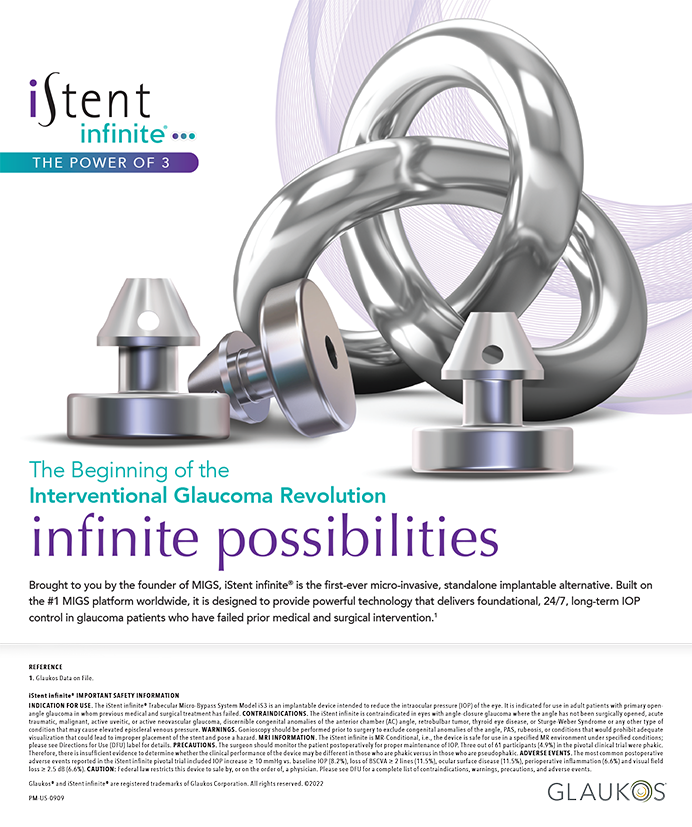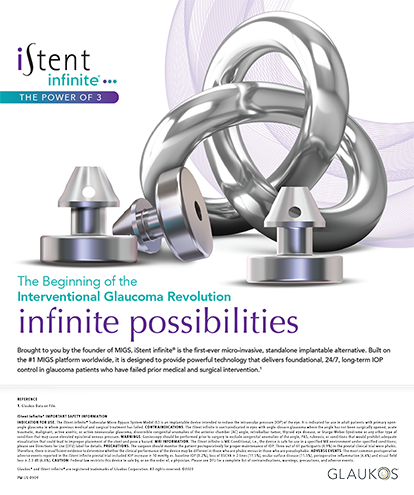
Subclinical Keratoconus Detection and Characterization Using Motion-Tracking Brillouin Microscopy
Randleman JB, Zhang H, Asroui L, Tarib I, Dupps WJ Jr, Scarcelli G1
Industry support: W.J.D., Medical advisory board (Alcon); G.S., Consultant and equity owner (Intelon Optics)
ABSTRACT SUMMARY
This prospective cross-sectional study used motion-tracking Brillouin microscopy (MTBM) to characterize changes in subclinical keratoconus (SKC) and evaluate whether MT Brillouin metrics could distinguish SKC eyes from control eyes.
Study in Brief
A prospective cross-sectional study evaluated the ability of a new method of Brillouin microscopy to detect early keratoconus (KC) and differentiate eyes with the disease from those with normal corneas. Motion-tracking Brillouin microscopy was able to differentiate early stages of KC with greater sensitivity and specificity than Scheimpflug tomography.
WHY IT MATTERS
Diagnosing subclinical KC is challenging. Most strategies investigated to date have used primarily morphologic rather than biomechanical parameters.
A total of 30 eyes of 30 patients (15 normal and 15 SKC eyes) were enrolled in the study. All patients underwent MTBM and Scheimpflug tomography. The former was performed with a custom-built device that generated mean and minimum MT Brillouin values within the anterior plateau region and anterior 150 µm. Scheimpflug metrics included the maximum keratometry reading; thinnest corneal thickness; inferior-superior value; indexes of surface variance, vertical asymmetry, height asymmetry, and height decentration; KC and central KC indexes; Ambrósio relational thickness; and Belin/Ambrósio display total thickness. The main outcome measure was discriminative performance based on sensitivity, specificity, and area under the receiver operating curve (AUC).
Distinct differences between SKC and control eyes were observed with MT Brillouin metrics for the mean plateau (5.71 vs 5.68 GHz; P < .0001), minimum plateau (5.69 vs 5.65 GHz; P < .0001), mean anterior 150 µm (5.72 vs 5.68 GHz; P < .0001), and minimum anterior 150 µm (5.70 vs 5.66 GHz; P < .001). All MT Brillouin plateau and anterior 150 µm mean and minimum metrics fully differentiated between the groups (AUC, 1.0 for each). The Scheimpflug metrics that performed the best were the KC index (AUC, 0.91), inferior-superior value (AUC, 0.89), and index of vertical asymmetry (AUC, 0.88).
DISCUSSION
The early detection and treatment of KC benefits both refractive surgery candidates and other individuals with SKC, particularly those who are young. SKC diagnosis, however, remains challenging.
MTBM allows noncontact, nonperturbative, all-optical mechanical mapping of the cornea with high 3D resolution.2-4 Brillouin frequency shift provides a quantitative estimation of the longitudinal modulus from optical spectroscopy.5 In their study,1 Randleman and colleagues used an advanced MTBM prototype to analyze corneal biomechanics. The investigators demonstrated the device’s ability to detect early KC with extremely high precision—better than with the other clinical and Scheimpflug tomography–based parameters. All the MTBM parameters evaluated were able to characterize focal corneal biomechanical weakening in the stroma of eyes with SKC and differentiate them from control eyes, including those that were not accurately differentiated from the normal cases using Scheimpflug metrics.
The MTBM device, if made commercially available, could become an important instrument for studying early KC and an essential tool of corneal surgeons.
Assessing Progression Limits in Different Grades of Keratoconus From a Novel Perspective: Precision of Measurements of the Corneal Epithelium
Ning R, Wang Y, Xu Z, et al6
Industry support: None
ABSTRACT SUMMARY
This study assessed (1) the repeatability and reproducibility of corneal epithelial thickness measurements with spectral-domain OCT and Placido disc topography in eyes with different stages of KC and (2) the limits of using this parameter to evaluate disease progression.
Study in Brief
A study examined the repeatability and reproducibility of corneal epithelial thickness measurements in eyes with different levels of keratoconus severity and assessed the limits of using this parameter to evaluate disease progression.
WHY IT MATTERS
Based on this study, it may be possible to use differences in minimal epithelial thickness to detect keratoconus and its progression.
Of the 149 eyes enrolled in the study, 29 had forme fruste KC, 34 had mild KC, and 46 had severe KC. The investigators measured minimal epithelial thickness (MET) values with OCT (MS39 CSO). They also assessed ET changes at different stages of disease severity. The stages corresponded to the Pentacam HR (Oculus Optikgeräte) topographic KC classification, which is based on anterior corneal surface parameters (index of surface variance, KC index, smallest radius) and categorizes eyes into three groups—mild, moderate, and severe.
The study also assessed intraoperator repeatability and interobserver reproducibility of measurements for the different disease stages. Both were acceptable across all three classes of KC severity, but reproducibility decreased in patients with advanced disease. The study set cutoff values of mild, moderate, and severe KC at 4.9, 5.2, and 7.4 µm, respectively, for thinnest ET. The detection of higher values at follow-up visits signaled possible disease progression. The investigators stated that, for central ET, the cutoff values for mild, moderate, and severe KC should be 2.8, 4.4, and 5.3 µm, respectively.
DISCUSSION
It is frequently challenging to determine whether KC is progressing. Disease progression is characterized by clinical indicators such as corneal thinning and increases in the maximum keratometry reading, posterior elevation, or aberrometry values of the anterior corneal surface. There is no global consensus, however, on how to characterize KC progression.
This study tested whether changes in ET mapping could be used to detect early KC progression. Ning and colleagues found that the repeatability and reproducibility of corneal epithelium measurements with the MS39 were acceptable in patients with KC but decreased gradually as disease severity increased. A stratified progression of the MET variability limits was associated with increased KC severity. Based on this study, a decrease in MET values may be a new indicator of KC progression.
1. Randleman JB, Zhang H, Asroui L, Tarib I, Dupps WJ Jr, Scarcelli G. Subclinical keratoconus detection and characterization using motion-tracking Brillouin microscopy. Ophthalmology. 2024;131(3):310-321.
2. Scarcelli G, Pineda R, Yun SH. Brillouin optical microscopy for corneal blindness. Invest Ophthalmol Vis Sci. 2012;53(1):185-190.
3. Scarcelli G, Yun SH. Confocal Brillouin microscopy for three-dimensional mechanical imaging. Nat Photonics. 2007;2:39-43.
4. Scarcelli G, Yun SH. In vivo Brillouin optical microscopy of the human eye. Opt Express. 2012;20(8):9197-9202.
5. Scarcelli G, Yun SH. Brillouin microscopy. In: Roberts CJ, Dupps WJ, Downs JC, eds. Biomechanics of the Eye. Kugler Publications; 2018:159-168.
6. Ning R, Wang Y, Xu Z, et al. Assessing progression limits in different grades of keratoconus from a novel perspective: precision of measurements of the corneal epithelium. Eye Vis (Lond). 2024;11(1):1.




